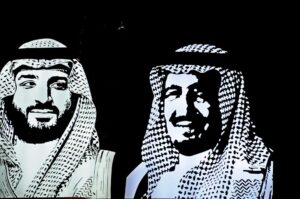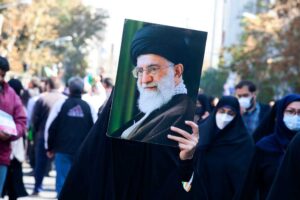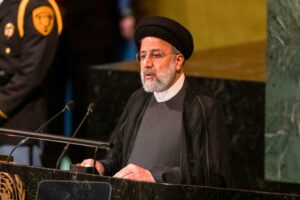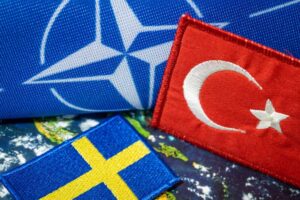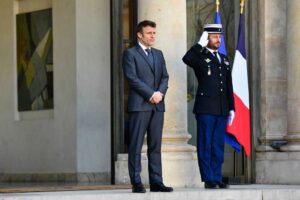Russia and China regard each other as important trade, economic, and geopolitical partners. Against the backdrop of their acrimonious bilateral relations with the United States and sensing opportunities provided by the prospect of reduced American engagement in the Middle East, Russia and China have sought out strategically useful partnerships in the region. The utility and the limits of close China-Russia alignment as it applies to the Middle East is best exemplified in the case of Iran.
China-Russia Relations in Perspective
The China-Russia relationship is at an historic high point,[i] fueled by a shared aversion to, and joint posturing against various aspects of the U.S.-led post-Cold War liberal international order, personal affinity between presidents Vladimir Putin and Xi Jinping, broadly compatible economies, and roughly similar regime types.
Interactions and collaboration between China and Russia, which have grown rapidly in recent years, encompass the defense, energy, and economic, as well as technology and cyber realms.[ii] Yet, the Sino-Russian partnership is one of increasing economic asymmetry.[iii] In addition, neither side has explicitly backed the other on the critical issues of Crimea/Eastern Ukraine and the South China Sea. In fact, the two countries’ interests, priorities, and objectives are not fully aligned in all areas.[iv] Such is the case in Central Asia, for example, where Russia seeks to maintain primacy in the face of growing Chinese involvement. To date, Beijing and Moscow have nonetheless found it useful — and possible — to accommodate each other’s interests and assertiveness.[v] Still, the growing power imbalance between them could limit the capacity for strategic coordination and spur greater competition or even tension in other areas where their interests overlap, notably the Middle East.
Chinese and Russian Engagement in the Middle East
The Middle East has long been at the center of global geopolitical competition for influence and resources. Today, it is a region where China and Russia are seeking to maximize opportunities to expand their footprint at the expense of the U.S. and major European powers that are seen as in decline.[vi] Yet, Beijing and Moscow define and rank their interests within the Middle East differently, pursue distinctive approaches to advancing their objectives, and deploy elements of national power in ways that reflect their respective ambitions and capabilities.
The Middle East has emerged as the most important region of the world for China after the Indo-Pacific. China’s principal interests in the region are economic. About half of China’s oil imports originate from the Middle East, mostly from Gulf producers. Since the Belt and Road Initiative (BRI) was launched in 2013, Chinese involvement throughout the region has become more extensive, with state-owned companies implementing major port-production facilities and other infrastructure projects in Egypt, Oman, Saudi Arabia, and the UAE. Thus far, though, China has not appeared interested in substantially ramping up its military presence and activities in the region.
The main thrust of Russia’s involvement in the Middle East is geopolitical. Russian policy in the region has long been defined by competition with the West, especially the United States.[vii] This still holds true. To be sure, today, as in the past, the Middle East is far less important to Moscow than relations with the U.S., Europe, or China. Nonetheless, Russia’s “return” to the role of an active player in the Middle East, culminating in its intervention in Syria, has served the aim of reestablishing itself as a major actor on the global stage. In addition, Russia has used its successful military intervention in the Syrian civil war as a springboard to cultivate ties with the Arab Gulf states, expand its nuclear export market, and boost its arms sales in the region.
Both China and Russia hold the West primarily responsible for the region-wide turmoil that has plagued the Middle East for over the past two decades. Moscow and Beijing alike support existing state structures and incumbent governments.
China and Russia’s security interests in the Middle East overlap. Like their Russian counterparts, Chinese officials are apprehensive about the spread of international terrorism and the prospect of instability spilling over into neighboring states and possibly their own territories.[viii] Both China and Russia hold the West primarily responsible for the region-wide turmoil that has plagued the Middle East for over the past two decades. Moscow and Beijing alike support existing state structures and incumbent governments against external intervention and internal insurrection; and are similarly comfortable working with opposing sides in any given conflict.
Yet, while Moscow and Beijing’s approaches to securing their interests and promoting regional stability are broadly compatible, the primary instruments they have harnessed to this purpose differ, reflecting divergent outlooks as well as asymmetrical capabilities. China has highlighted the role of development as a means of overcoming destructive rivalries, and pledged billions of dollars in loans and financial aid to revive economic growth in the Middle East.[ix] By contrast, Russia’s approach has leaned heavily on proactive multilateral diplomacy mixed with the projection of power and force.
China’s financial heft has been instrumental in its development of multidimensional ties with MENA countries, from Morocco to Oman. However, Chinese trade and investment activities in the region are sharply skewed towards the Gulf Arab countries.[x] Unlike China, Russia’s relations with the Middle East are not supported by large trade or investment flows.[xi] The net result is that China’s two-way trade with the MENA countries dwarfs that of Russia, as does Chinese investment in the region.[xii]
The value of Russian weapons sales to the Middle East far exceeds those of China.
The linchpin of Moscow’s interests in the region is Syria, where its 2015 military intervention catapulted Russia from a marginal actor to a major power broker.[xiii] Since then, Russia has made great effort to reclaim its role as the arms supplier of choice for Arab governments. To date, the value of Russian weapons sales to the Middle East far exceeds those of China,[xiv] though the latter has made some significant inroads in niche categories in the region’s arms market.
Despite and perhaps partly because the scope, emphasis, and concrete substance of China and Russia’s policies in the Middle East differ, Beijing and Moscow have managed to cooperate with one another on matters where their interests converge. They have forged a unified voting bloc in the UN Security Council on several key issues related to the Middle East. The most notable case is Syria, where China has vetoed a total of ten UNSC resolutions on Syria, compared with Russia’s sixteen.[xv] The fact that Beijing has generally supported Russian-led initiatives regarding Syria has suited them both, as, through close alignment on Syria,[xvi] China and Russia have provided each other with diplomatic cover. However, regarding policy toward Iran, the situation is far more complicated.

Russia and China in Iran
The case of Iran provides insights into the utility and limitations of Sino-Russian alignment and reveals the complexity of their respective relationships with regional partners. The bilateral legs and triangular relationship between China, Russia, and Iran are underpinned by a shared aspiration to create a multipolar world and common opposition to perceived U.S. unilateralism and Western-led or pro-Western regime change. Indeed, what is striking about this triangular relationship is how closely its trajectory has mirrored, and indeed, has been structured by the ups and downs of the three countries’ relations with the United States.
Russia and China have taken steps in tandem to support Iran in the United Nations.
Over the years, Russia and China have taken steps in tandem to support Iran in the United Nations, notably working together to temper international sanctions.[xvii] Russia and China appear to have drawn closer to Iran since the unilateral U.S. withdrawal from the JCPOA and as both Moscow and Beijing’s relations with Washington have continued to deteriorate. China and Russia coordinated their responses to the January 2020 U.S. strike on Iranian General Qasem Soleimani;[xviii] rejected the American attempt to extend the arms embargo on Iran that expired in October 2020; endorsed Iran’s admission as a full member to the Shanghai Cooperation Organization (SCO);[xix] and participated in joint naval exercises in the Gulf of Oman and the Indian Ocean as well as in the Persian Gulf.
Nevertheless, these steps do not amount to a tight strategic convergence. Sino-Russian approval of Iran’s full accession to the SCO has conferred on Iran more prestige than real power. When the United States withdrew from the JCPOA, Chinese and Russian banks reduced their transactions with Iran,[xx] and the China National Petroleum Corporation (CNPC) withdrew from a major natural-gas project.[xxi] Recent calls by Chinese and Russian officials for the U.S. to rejoin the JCPOA[xxii] were more a display of solidarity in the face of new human rights-related Western sanctions against them than of standing shoulder-to-shoulder with Iran. China-Russia opposition to the renewal of the U.N. arms embargo has not (yet) resulted in any major new weapons sales to Iran. And officials from both China and Russia have been careful to downplay the naval drills with Iran, describing them as “normal military exchanges.”[xxiii]
The China-Russia-Iran “axis,” much as it may resemble one, consists of a malleable set of bilateral, transactional relationships marked by stark power asymmetries.
Thus, no “tripartite axis” exists — certainly not in the sense of formalized commitments akin to an alliance. Neither is there an institutional structure that binds the three to one another. On the contrary, the China-Russia-Iran “axis,” much as it may resemble one, consists of a malleable set of bilateral, transactional relationships marked by stark power asymmetries and driven mainly by need (Iran) or by a combination of ambition and expediency (China and Russia).
China and Russia are drawn to Iran for broadly similar reasons. Both Beijing and Moscow regard their relations with Iran to be useful as leverage over Western countries and as an important regional security actor, whose cooperation they seek in maintaining stability and whose ability to foment trouble they recognize well.[xxiv] China and Russia also value Iran for its location at the crossroads of the Middle East and Central Asia. Just as Iran is a pivotal node in China’s BRI, it occupies an important place in Moscow’s ambitious greater Eurasia project given that the International North-South Transport Corridor (INSTC) and the Caspian Development Strategy rely on Iranian port infrastructure and overland trade routes to expand Russian exports into the Persian Gulf and South Asian markets.[xxv]
Yet, in pursuing long-term returns in their relations with Iran, both Beijing and Moscow have been practicing short-term hedging. The 20-year agreement between Russia and Iran has yet to be renewed.[xxvi] The widely reported China-Iran Strategic Cooperation Agreement is an aspirational document lacking measurable goals or specific projects.[xxvii] Whether the reported 25-year deal between Beijing and Tehran, which could pave the way for substantial Chinese investment in Iran’s strategically important sectors, might be implemented is unclear.
Much as they might be tempted to prioritize their relations with Iran, Beijing and Moscow are intent on deepening cooperation with the Gulf Arab states.
None of this should be surprising, as China-Iran and Russia-Iran relations are not just pragmatic partnerships but constrained ones. International sanctions have done nearly as much to hamper as to propel these relationships. Furthermore, much as they might be tempted to prioritize their relations with Iran, Beijing and Moscow are intent on deepening cooperation with the Gulf Arab states — an aim that China, especially, has made great progress toward achieving and that could be jeopardized by tilting too far in Iran’s favor.
Equally significant, relations between Moscow and Tehran have frequently been contentious.[xxviii] Although Russia and Iran have worked together to maintain the Syrian regime in power and battled extremist forces,[xxix] they have disagreed on combat operations,[xxx] military reform,[xxxi] the longevity of the Assad regime, the future of Syrian Kurds, and the role of paramilitary groups.[xxxii] China-Iran relations are generally unencumbered by policy differences such as these. But Beijing is no less troubled than Moscow by Iran’s support for terrorist movements and insurgencies, repeated threats to close the Strait of Hormuz, and other provocative behavior.
Tehran, too, has experienced its share of disappointments and frustrations. Iranian distrust of Russia has a long history, with dissatisfaction in recent years stemming from long delays in the completion of the Bushehr nuclear reactor and in the delivery of the S-300 missile system, as well as from UN Security Council votes against Iran taken by Moscow.[xxxiii] Iran’s largest trading partner, leading export destination, and economic lifeline is China. Nevertheless, Iranian officials are undoubtedly mindful of the fact that the relationship with China has been a limited, lopsided, and largely dependent one where Beijing has repeatedly sacrificed its relationship with Tehran for the sake of managing its relations with the West and the Gulf Arab states.[xxxiv] Pursuing a strategy of ‘maximum resistance’ and isolated from the West, Iran has sought shelter in relations with Russia and China — an approach that has helped ensure the regime’s survival though it has yet to unleash the country’s full potential.
Iranian Foreign Minister Hossein Amir-Abdollahian’s recent remarks — where, while in Moscow, he expressed Tehran’s preference for “the East to the West” [xxxv] but subsequently referred to “a balanced foreign policy” and “active and dynamic relations with the East and West” as a priority — encapsulate Iran’s dilemma. They also underscore the tension between aligning closely with Beijing and Moscow and keeping them at bay.[xxxvi]

Conclusion
The China-Russia relationship serves as a vehicle for balancing against the United States during a time when Moscow and Beijing both perceive Washington to have grown more hostile.[xxxvii] This dynamic can be seen at work in aspects of China and Russia’s growing involvement in the Middle East, particularly regarding relations with Iran. The China-Russia-Iran relationship is often misrepresented as a close alignment on the verge of becoming an anti-Western strategic “axis.” But this (mis-)characterization masks the three countries’ asymmetries of power and divergences in their interests and outlooks.
The prospect of a new nuclear agreement would provide an opportunity for the three countries to draw on the geopolitical and economic dividends of the relationships they have developed in recent years. A no-deal scenario or endless negotiations could likewise provide China and Russia with justification for expanding trade, arms sales, and investment activities in Iran — though at the risk of furthering damaging relations with the West and alienating Iran’s neighbors. In neither case, however, should one expect such gains to be distributed evenly. Unfettered Iranian hydrocarbon exports, for example, would presumably accrue to China’s benefit but jeopardize Russia’s pre-eminence among Eurasian energy suppliers.
To date, China, Russia, and Iran have managed to compartmentalize their differences. That might not always be possible. Neither Moscow nor Beijing’s vision of the future of the region aligns closely with that of Tehran. The climate and substance of China-Russia-Iran relations could change as all three maneuver to achieve or maintain their dominance in areas where their interests and ambitions intersect. While, in theory, the North-South axis of Russia’s INSTC can complement the East-West axis of China’s BRI, these schemes could come to fuel China-Russia competition rather than cement China-Russia-Iran cooperation. Furthermore, Iran’s “Pivot to the East” may not prove to be a permanent feature of the regional and global landscape. Neither may the tight strategic convergence between China and Russia.
[i] https://www.globaltimes.cn/page/202106/1227248.shtml; and Vasily Kashin, “Russia and China Take Military Partnership to New Level,” Moscow Times, October 23, 2019, https://www.themoscowtimes.com/2019/10/23/russia-and-china-take-military-partnership-to-new-level-a67852.
[ii] Andrea Kendall-Taylor and David Shullman, “Navigating the Deepening Russia-China Partnership,” Center for New American Security (CNAS) Report, January 14, 2021, https://s3.us-east-1.amazonaws.com/files.cnas.org/documents/CNAS-Report-Russia-China-Alignment-final-v2.pdf?mtime=20210114133035&focal=none.
[iii] Jonathan E. Hillman, “China and Russia: Economic Unequals,” CSIS Report (July 15, 2020), https://csis-website-prod.s3.amazonaws.com/s3fs-public/publication/200715_ChinaandRussia.pdf; Olga Alexeeva and Frédéric Lasserre (trans. Elizabeth Guill), “The Evolution of Sino-Russian Relations as Seen from Moscow: The Limits of Strategic Rapprochement,” China Perspectives 3 (2018): 69-77; and Ian Hill, “Russia-China: An Unholy Alliance?” The Interpreter, May 14, 2021, https://www.lowyinstitute.org/the-interpreter/russia-china-unholy-alliance.
[iv] Pavel K. Baev, “Russia and China: A Mutually Exaggerated Strategic Partnership?” China Brief 21, 20 (October 22, 2021), https://jamestown.org/program/russia-and-china-a-mutually-exaggerated-strategic-partnership; Natasha Kuhrt, “Russia and China present a united front to the west – but there’s plenty of potential for friction,” The Conversation, March 29, 2021, https://theconversation.com/russia-and-china-present-a-united-front-to-the-west-but-theres-plenty-of-potential-for-friction-157934; and Bradley Jardine and Edward Lemon, “In Russia’s Shadow: China’s Rising Security Presence in Central Asia,” Kennan Institute, May 2020, https://www.wilsoncenter.org/sites/default/files/media/uploads/documents/KI_200519_cable%2052_v1.pdf.
[v] Bobo Lo, “The Sino-Russian Partnership and Global Order,” China International Strategy Review 2, no. 2 (December 2020): pp. 306-324, https://doi.org/10.1007/s42533-020-00063-7.; and Marcin Kaczmarski, “The Sino-Russian Relationship and the West,” Survival 62, 6 (December 2020): pp. 199-212, https://doi.org/10.1080/00396338.2020.1851101.
[vi] Robert Sutter, “China-Russia Relations, Strategic Implications and U.S. Policy Options,” NBR Special Report 73, September 2018, https://www.nbr.org/wp-content/uploads/pdfs/publications/special_report_73_china-russia_cooperation_sep2018.pdf.
[vii] Seva Gunitsky, “One Word to Improve U.S. Russia Policy – ‘Derzhavnost’: It’s why focusing on Putin, or trying to punish the country, usually backfires,” New Republic, April 27, 2018.
[viii] Eugene Rumer, “Russia in the Middle East: Jack of All Trades, Master of None,” Carnegie Endowment for International Peace (October 2019): 3, https://carnegieendowment.org/files/WP-Rumer-MiddleEast.pdf.
[ix] “China’s Xi pledges $20 billion in loans to revive Middle East,” Reuters, July 9, 2021, https://www.reuters.com/article/us-china-arabstates/chinas-xi-pledges-20-billion-in-loans-to-revive-middle-east-idUSKBN1K0072.
[x] John Calabrese, “China’s Maritime Silk Road and the Middle East: Tacking Against the Wind,” Middle East Institute, May 20, 2020, https://www.mei.edu/publications/chinas-maritime-silk-road-and-middle-east-tacking-against-wind.
[xi] Dmitriy Frolovskiy, “Russia’s involvement in the Middle East: Building sandcastles and ignoring the streets,” Middle East Institute, June 1, 2020, https://www.mei.edu/publications/russias-involvement-middle-east-building-sandcastles-and-ignoring-streets.
[xii] See World Bank, World Integrated Trade Solution (WITS), https://wits.worldbank.org/Default.aspx?lang=en.
[xiii] Rumer, “Russia in the Middle East: Jack of All Trades, Master of None,” 10.
[xiv] Pieter D. Wezeman, Alexandra Kuimova, and Siemon T. Wezeman, “Trends in International Arms Transfers, 2020,” Stockholm Peace Research Institute (SIPRI), March 2021, https://www.sipri.org/sites/default/files/2021-03/fs_2103_at_2020_v2.pdf.
[xv] For a full list of U.N. Security Council vetoes, see https://research.un.org/en/docs/sc/quick/veto
[xvi] Yixiang Xu, “Evolving Sino-Russian Cooperation on Syria,” U.S. Institute of Peace, October 3, 2017, https://www.usip.org/sites/default/files/2017-10/pb236-evolving-sino-russian-cooperation-in-syria.pdf;
[xvii] John W. Parker, “Russia and the Iranian Nuclear Program: Replay or Breakthrough?” INSS Strategic Perspective 9 (2012), https://ndupress.ndu.edu/Portals/68/Documents/stratperspective/inss/Strategic-Perspectives-9.pdf.
[xviii] Ankit Panda, “After US strike on Soleimani, China and Russia coordinate at UN,” The Diplomat, January 8, 2020.
[xix] “Iran Joins Russia, China in Shanghai Cooperation Organization,” Al-Monitor, September 9, 2021, https://www.al-monitor.com/originals/2021/09/iran-joins-china-russia-shanghai-cooperation-organization.
[xx] “Chinese, Russian Banks Refuse Transactions with Iran,” Radio Farda, August 5, 2020, https://en.radiofarda.com/a/chinese-russian-banks-refuse-transactions-with-iran/30767647.html.
[xxi] Benoit Faucon, “China Pulls Out of a Giant Iranian Gas Project,” October 6, 2019, Wall Street Journal, https://www.wsj.com/articles/china-pulls-out-of-giant-iranian-gas-project-11570372087.
[xxii] “China, Russia officials meet in a show of unity against EU, US,” AP, March 23, 2021, https://apnews.com/article/joe-biden-europe-beijing-wang-yi-coronavirus-pandemic-b8797b405a609945eef3a8dade8b12e1.
[xxiii] Ben Westcott and Hamdi Alkshali, “China, Russia and Iran hold joint drills in Gulf of Oman,” CNN, December 27, 2019, https://www.cnn.com/2019/12/27/asia/china-russia-iran-military-drills-intl-hnk/index.html.
[xxiv] Stephen Blank, “The Foundations of Russian Policy in the Middle East,” Jamestown Foundation, October 5, 2017, https://jamestown.org/program/foundations-russian-policy-middle-east/#_edn25.
[xxv] Nicole Grajewski, “Friends or Frenemies? How Russia and Iran Compete and Cooperate,” Foreign Policy Research Institute (FPRI), March 12, 2020, https://www.fpri.org/wp-content/uploads/2020/03/rfp-1-grajewski-final.pdf.
[xxvi] Mohammad Hadi Shamkhani, “Why there is no news of extending 20-year agreement between Iran and Russia,” Tehran Times, February 22, 2021, https://www.tehrantimes.com/news/458433/Why-there-is-no-news-of-extending-20-year-agreement-between-Iran. See also Alex Vatanka, “Iran and Russia: A tale of unfulfilled economic potential,” Middle East Institute, March 17, 2020, https://www.mei.edu/publications/iran-and-russia-tale-unfulfilled-economic-potential.
[xxvii] William Figueroa, “China-Iran Relations: The Myth of Massive Investment,” The Diplomat, April 6, 2021.
[xxviii] Mark N. Katz, “Elusive as Ever: The State of Iranian-Russian Cooperation,” Wilson Center Viewpoints 73 (March 2015), https://www.wilsoncenter.org/sites/default/files/media/documents/publication/elusive_as_ever_state_of_iranian_russian_cooperation.pdf.
[xxix] Samuel Ramani, “Russia and Iran in Syria: Military Allies or Competitive Partners?” LSE Blog, July 3, 2021, https://blogs.lse.ac.uk/mec/2021/07/03/russia-and-iran-in-syria-military-allies-or-competitive-partners/; Oula A. Alrifai and Ali Alleile, “Iran and Russia Are Exploiting America’s Absence in Northeast Syria,” WINEP Policy Analysis, July 29, 2021, https://www.washingtoninstitute.org/pdf/view/16929/en.
[xxx] Anne Barnard and Andrew E. Kramer, “Iran Revokes Russia’s Use of Air Base, Saying Moscow ‘Betrayed Trust,’” New York Times, August 22, 2016, https:// www.nytimes.com/2016/08/23/world/middleeast/iran-russia-syria.html.
[xxxi] Kirill Semenov, “Russia, Iran in Tug of War Over Syria Military Reform,” Al-Monitor, June 10, 2019, https://www.al-monitor.com/pulse/originals/2019/06/russia-iran-syria-military-reform.
[xxxii] Ellie Geranmayeh and Kadri Liik, “The new power couple: Russia and Iran in the Middle East,” European Council on Foreign Relations (ECFR) Policy Brief 186 (March 2016), https://ecfr.eu/publication/iran_and_russia_middle_east_power_couple_7113/.
[xxxiii] Dmitri Trenin, “Russia and Iran: Historic Mistrust and Contemporary Partnership,” Carnegie Moscow Center, August 2016, https://carnegiemoscow.org/2016/08/18/russia-and-iran-historic-mistrust-and-contemporary-partnership-pub-64365.
[xxxiv] John Calabrese, “Sino-Iran Relations and Chinese Engagement in the Middle East,” U.S.-China Economic and Security Review Commission, September 9, 2020, https://www.uscc.gov/sites/default/files/2020-09/Calabrese_Statement.pdf; and “China-Iran Relations: The Not-So-Special ‘Special Relationship,’” China Brief 20, 5 (March 16, 2020), https://jamestown.org/program/china-iran-relations-the-not-so-special-special-relationship/.
[xxxv] Maziar Motamedi, “Iran looking for ‘big jump’ in Russia relations with Moscow talks,” Aljazeera, October 6, 2021, https://www.aljazeera.com/news/2021/10/6/iran-looking-for-big-jump-in-relations-after-moscow-talks; “Details of Imam Khamenei’s Strategic Letter to the President,” Khamenei.ir, February 15, 2021, https://english.khamenei.ir/news/8362/Details-of-Imam-Khamenei-s-strategic-letter-to-Russia-s-President.
[xxxvi] Maryam Sinaee, “Strong Ties with Russia, China Do Not Exclude Relations With West: Iran FM,” Iran International, October 10, 2021, https://www.iranintl.com/en/20211010595617.
[xxxvii] Andrew Radin et al., China-Russia Cooperation: Determining Factors, Future Trajectories, Implications for the United States. Santa Monica, CA: RAND Corporation, 2021, https://www.rand.org/content/dam/rand/pubs/research_reports/RR3000/RR3067/RAND_RR3067.pdf.







